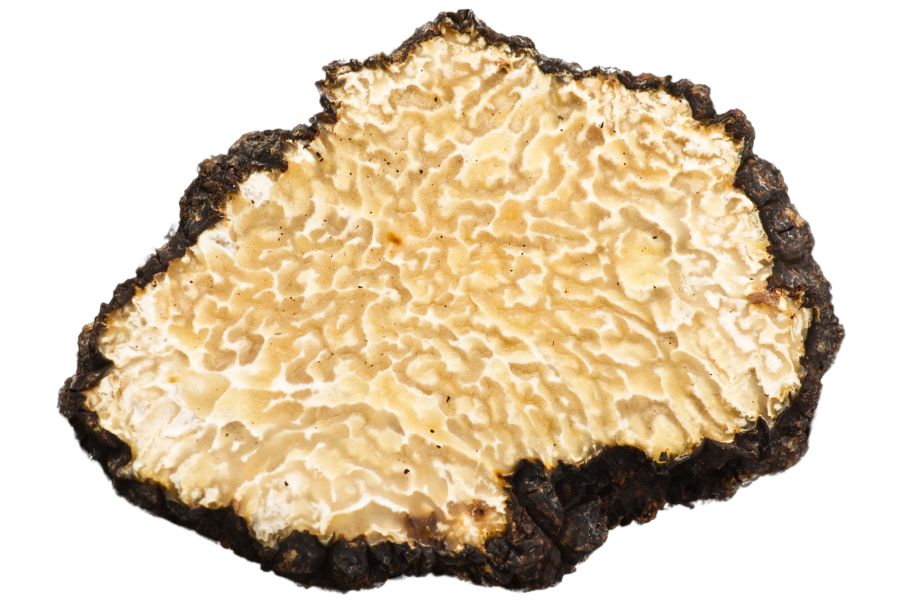Minnesota’s wild forests hold more than just chanterelles and morels. Hidden beneath the soil, truffles offer a rare reward for those who know how to search.
The value of these fungi comes from more than scarcity. Their deep, rich flavor and underground nature have made them prized ingredients around the world.
Most people have no idea these mushrooms grow wild in the state. But with a little knowledge, you could be one of the few to walk away with some of the most impressive mushrooms Minnesota has to offer.
What We Cover In This Article:
- What Wild Truffles Look Like
- Truffle Lookalikes To Avoid
- Best Practices For Finding Truffles
- Where You Can Find Truffles Around The State
- Other Great Locations For Truffles
- When The Best Time Of The Year Is To Find Truffles
- The extensive local experience and understanding of our team
- Input from multiple local foragers and foraging groups
- The accessibility of the various locations
- Safety and potential hazards when collecting
- Private and public locations
- A desire to include locations for both experienced foragers and those who are just starting out
Using these weights we think we’ve put together the best list out there for just about any forager to be successful!
A Quick Reminder
Before we get into the specifics about where and how to find these plants and mushrooms, we want to be clear that before ingesting any wild plant or mushroom, it should be identified with 100% certainty as edible by someone qualified and experienced in mushroom and plant identification, such as a professional mycologist or an expert forager. Misidentification can lead to serious illness or death.
All plants and mushrooms have the potential to cause severe adverse reactions in certain individuals, even death. If you are consuming wild foragables, it is crucial to cook them thoroughly and properly and only eat a small portion to test for personal tolerance. Some people may have allergies or sensitivities to specific mushrooms and plants, even if they are considered safe for others.
The information provided in this article is for general informational and educational purposes only. Foraging involves inherent risks.
What Wild Truffles Look Like
The U.S. is home to several native truffle species that grow wild in forests across the country. Each one has its own unique scent, appearance, and preferred habitat. Here are the types of truffles you can find:
Oregon Black Truffles (Leucangium carthusianum)

Leucangium carthusianum, also called the Oregon black truffle, grows in the Pacific Northwest and usually shows up around Douglas-fir trees. It’s a native species and one of the more well-known edible truffles from the region.
On the outside, it looks like a small lump of coal—dark black, kind of lumpy or warty, and sometimes slightly smoother in spots. They’re usually about the size of a golf ball, but they can be smaller or larger depending on the season.
Inside, the truffle is firm with a marbled pattern of gray and white veins running through it. When it’s fresh, it smells fruity, almost like pineapple, but the scent gets stronger and muskier as it ripens.
If you’re out looking for them, check in moist, shady forests with soft, loamy soil, especially where there’s a lot of moss or ferns. They grow just below the surface, so people often use trained dogs to help sniff out the ripe ones.
Compared to the Oregon white truffle, which is lighter in color and has a sharper, garlicky aroma, the black truffle has a deeper, more earthy smell. It’s also bigger and firmer than the southern U.S. truffles like Tuber lyonii, which tend to be smaller, paler, and grow around hardwoods like oaks and hickories.
Oregon Winter White Truffles (Tuber oregonense and Tuber gibbosum)
Oregon has two native white truffles that are starting to get more attention: the Oregon Winter White Truffle (Tuber oregonense) and the Oregon Spring White Truffle (Tuber gibbosum). They grow underground in forests and are prized for their strong, savory aroma.
From the outside, these truffles are small, roundish, and kind of bumpy, usually pale beige to light brown. Cut one open, and you’ll see a white interior that darkens with age, showing off a web of white veins when it’s fully mature.
The Winter White Truffle pops up from late fall into February, while the Spring White starts showing up around January and can last into June. They’re pretty similar, but the Winter variety is known for having a more powerful scent and flavor.
To find them, you’ll want to look in forests with younger Douglas-fir trees on the west side of the Cascades. Truffle hunters often check for loose soil or spots where animals have been scratching, which can be a sign there’s something below.
When fully ripe, both types give off a bold smell that’s often compared to garlic, cheese, or earthy spices. They’re usually served raw, shaved over dishes to add that truffle kick without losing any of the aroma.
Appalachian Truffle (Tuber canaliculatum)
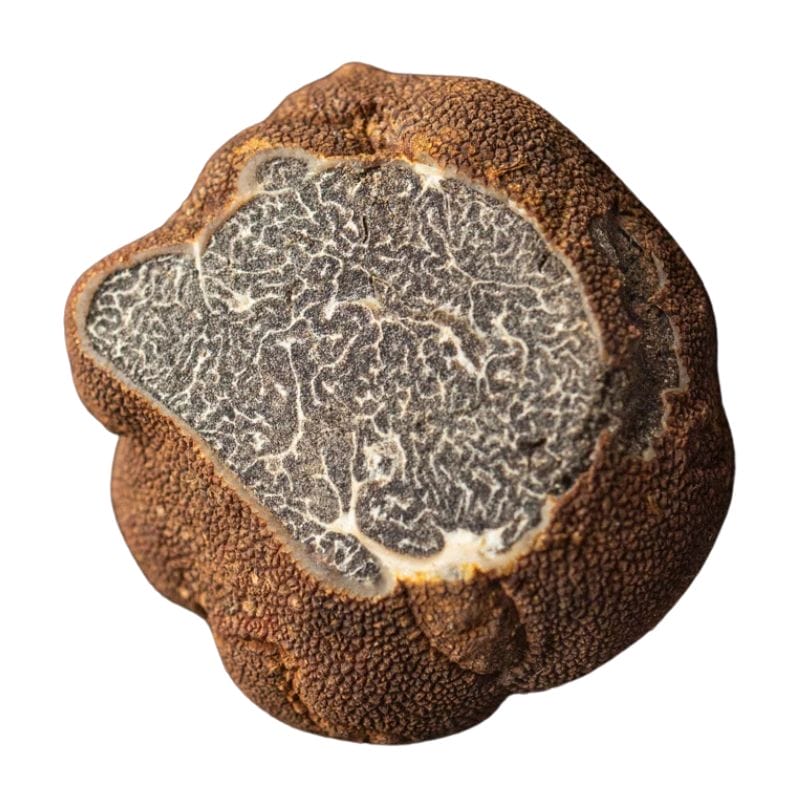
The Appalachian truffle, also known as Tuber canaliculatum, is a native North American truffle that’s slowly getting noticed. It’s about the size of a walnut and has a reddish-brown, bumpy outer surface that looks kind of like a rough, warty potato.
When you cut it open, the inside is firm and dark brown with thin white veins running through it like a marbled pattern. If it’s fully ripe, the smell is strong and earthy—some say it has a kind of nutty, funky aroma that stands out.
You can find these truffles in mixed hardwood forests, especially around oaks and pines, from late summer through fall. They grow underground, so look for spots where the soil is loose and animals like squirrels have been digging—sometimes that’s a good clue.
If you’re foraging, gently raking the top layer of soil near tree roots can help, but a trained dog or even a good nose makes it way easier. Once you know what to look for, the reddish color and bumpy skin are good signs you’ve found the right thing.
Compared to truffles like Tuber oregonense or Leucangium carthusianum, Tuber canaliculatum is more subtle in every way. Its smaller size and lighter scent mean you have to pay closer attention when foraging.
It’s also not as popular in the culinary world because it doesn’t pack the same punch in terms of flavor or aroma. Still, finding one can be rewarding, especially if you’re exploring different types of fungi in the area.
Desert Truffle (Terfezia and Tirmania spp.)
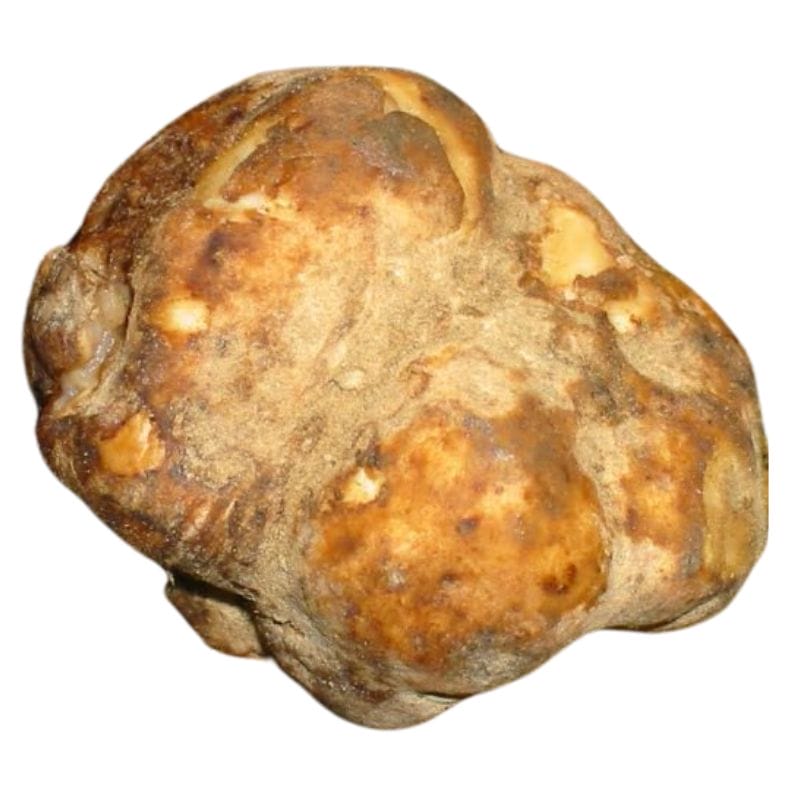
Terfezia and Tirmania are two types of truffles that are sometimes called desert truffles. These are a bit different from the truffles we usually think of, with their bold flavors and rich aromas.
These ones are a little more understated, but they’re fascinating in their own right. What makes them stand out is their ability to thrive in dry, harsh environments where you wouldn’t expect something so delicate to grow.
Unlike the earthy, intense aroma of black or white truffles, Terfezia and Tirmania truffles have a milder scent and flavor. They’re often described as nutty, with a hint of sweetness, but they lack the strong garlicky or musky notes you might associate with other truffles.
Their texture is also different—more firm and less oily than what you’d find with species like Tuber oregonense. They might not have the same culinary punch, but they’re still prized in traditional dishes, where their subtle flavors shine in simpler recipes.
When it comes to appearance, they’re easy to spot once you know what you’re looking for. They’re round to slightly irregular in shape, and their color can range from light beige to a reddish-brown, depending on the species.
The surface is usually smooth or slightly textured, without the rough, knobby look of a black truffle. Cut one open, and you’ll see a pale interior that’s often uniform in color, lacking the intricate veining you’d see in something like Leucangium carthusianum.
Pecan Truffle (Tuber lyonii)
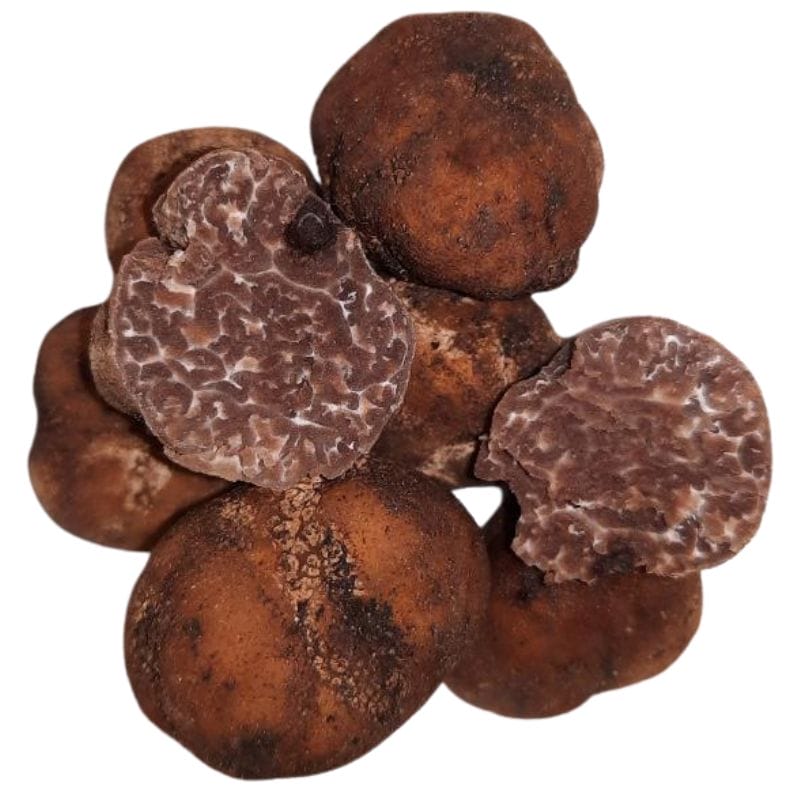
Tuber lyonii, also known as the pecan truffle, is a native North American truffle that grows underground near the roots of pecan trees. You’ll mostly find it in the southeastern U.S., especially in states like Texas, Georgia, and Mississippi.
On the outside, pecan truffles are round to lumpy and have a smooth, light brown skin that darkens as they age. They’re usually about the size of a marble or golf ball, and sometimes they even poke up slightly through the soil surface.
If you slice one open, the inside has a pretty marbled look—light tan streaks mixed with darker brown, almost like wood grain. The smell is earthy, nutty, and kind of warm, especially when they’re fully mature.
When you’re out looking for them, check under mature pecan trees or other hardwoods like oaks and hickories. Trained dogs can help sniff them out, but people sometimes spot them by looking for little cracks in the soil or raised areas near the tree’s base.
Compared to other U.S. truffles like the Oregon white truffle or the Appalachian black truffle, pecan truffles have a milder flavor and are more common in orchards. They’re a solid option in the kitchen—freshly sliced over pasta or mixed into butter—and they don’t come with the high price tag of their European cousins.
Truffle Lookalikes To Avoid
When you’re out hunting you also need to know about a few different fungi species that look very similar to the delicious truffles we’re after but are either inedible or not worth eating. Keep an eye out for:
Pine Truffles (Geopora cooperi)
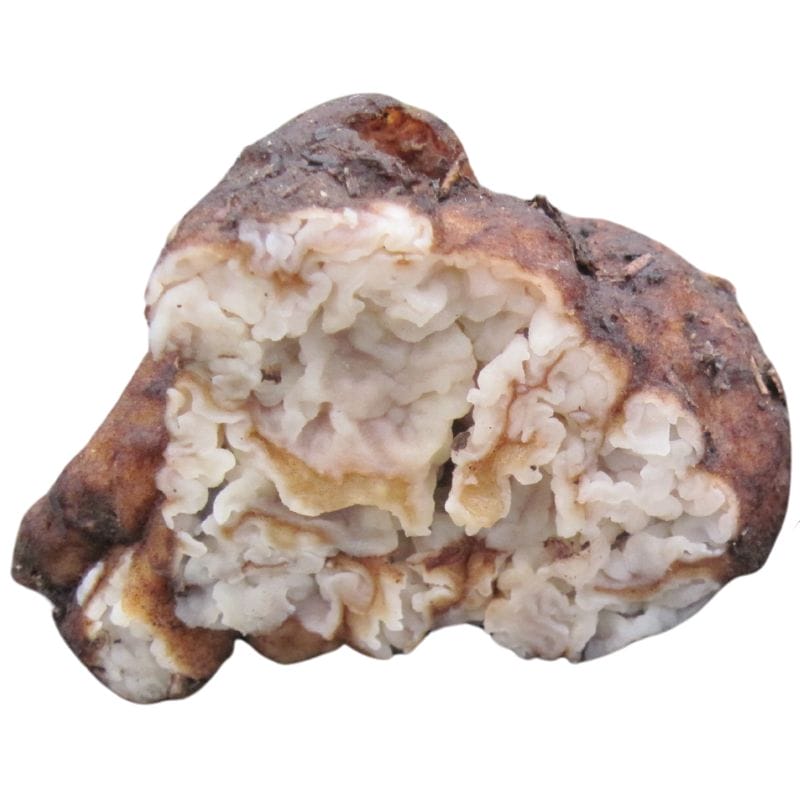
Geopora cooperi is a fungus that can easily confuse someone new to truffle hunting. It’s sometimes called the pine truffle because it grows underground like a true truffle and often pops up near certain trees.
At first glance, it might seem like you’ve hit the jackpot, but this one is a false truffle, not something you’d want to eat or sell.
The easiest way to tell Geopora cooperi apart from real truffles is by looking closely at its structure. While true truffles have a smooth or slightly knobby exterior and a marbled interior, Geopora cooperi has a rougher, more irregular outer surface.
When it matures, it sometimes splits open, revealing a cup-like shape, which true truffles never do. Inside, it’s less dense and doesn’t have the intricate veining that makes real truffles so unique.
Another big difference is the smell. True truffles have a strong, rich aroma that’s earthy, sweet, or garlicky, depending on the species. Geopora cooperi, on the other hand, has a much weaker scent, and it’s not as pleasant or distinctive.
If you’re relying on aroma to identify your find, this one will give itself away pretty quickly. So, while it might look similar at first, a closer inspection will show it’s not the culinary treasure you’re hoping for.
Stinking Slime Truffle (Melanogaster ambiguus)
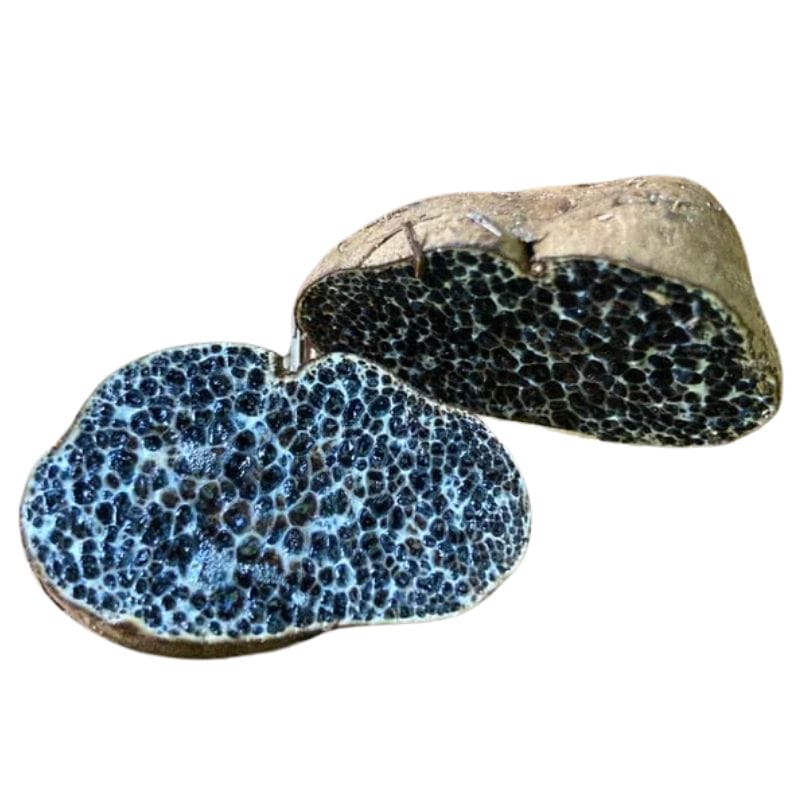
Melanogaster Ambiguus, because of their reddish-brown to dark brown exterior, might look like true truffles at first glance, but they’re quite different when you know what to look for.
The key difference is on the inside. When you cut open Melanogaster ambiguus, the interior is filled with flattened cells that have a shiny black gelatinous feel to them. Real truffles, on the other hand, have those beautiful marbled veins running through their flesh, almost like a web.
Another giveaway is the smell. While real truffles have a rich, earthy aroma that’s mouthwatering, Melanogaster ambiguus tends to have a much stronger, almost unpleasant odor—it’s not something you’d want to sprinkle on your pasta.
Earthballs (Scleroderma)
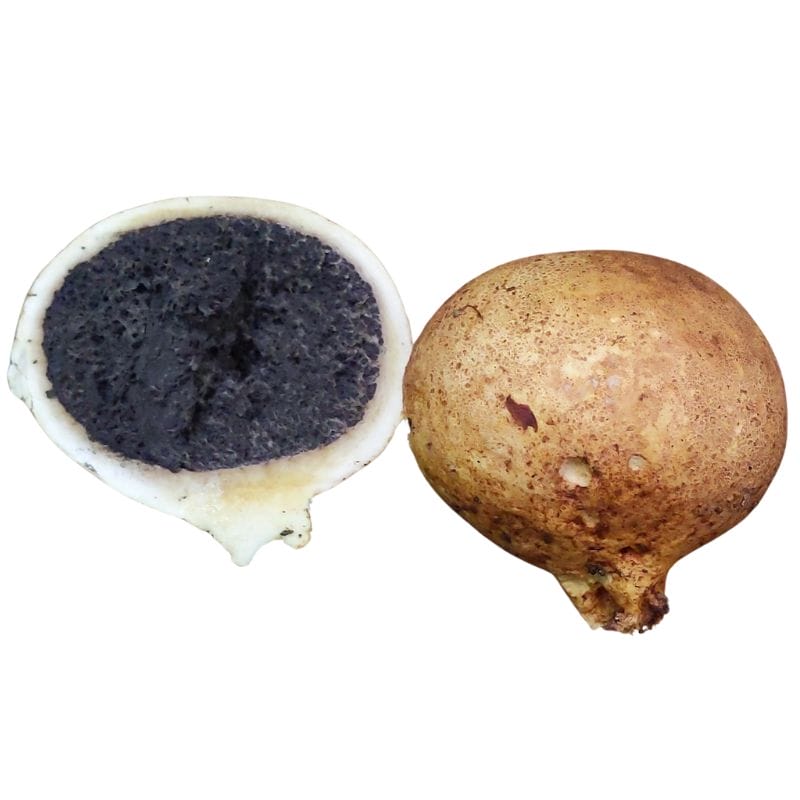
Scleroderma, commonly called earthballs, can easily fool someone who’s just starting out because they grow underground and have a round shape similar to truffles. But don’t be tricked—Scleroderma is not a true truffle, and it’s actually toxic, so it’s important to know how to tell the difference.
The first thing you’ll notice is the outer skin, which is thicker and tougher than that of most truffles. It can range in color from yellowish to dark brown, often with a rough or cracked texture.
If you cut it open, the difference becomes even clearer. While true truffles have a marbled interior with delicate white veins, Scleroderma starts out with a whitish inside that quickly darkens as it matures, turning black or purple with no marbling. It’s dense and solid, almost like charcoal in the later stages.
Another big giveaway is the smell. True truffles have a rich, earthy aroma that makes them so prized, while Scleroderma has little to no pleasant scent—some even describe it as musty or unpleasant.
Deer Truffles (Elaphomyces)
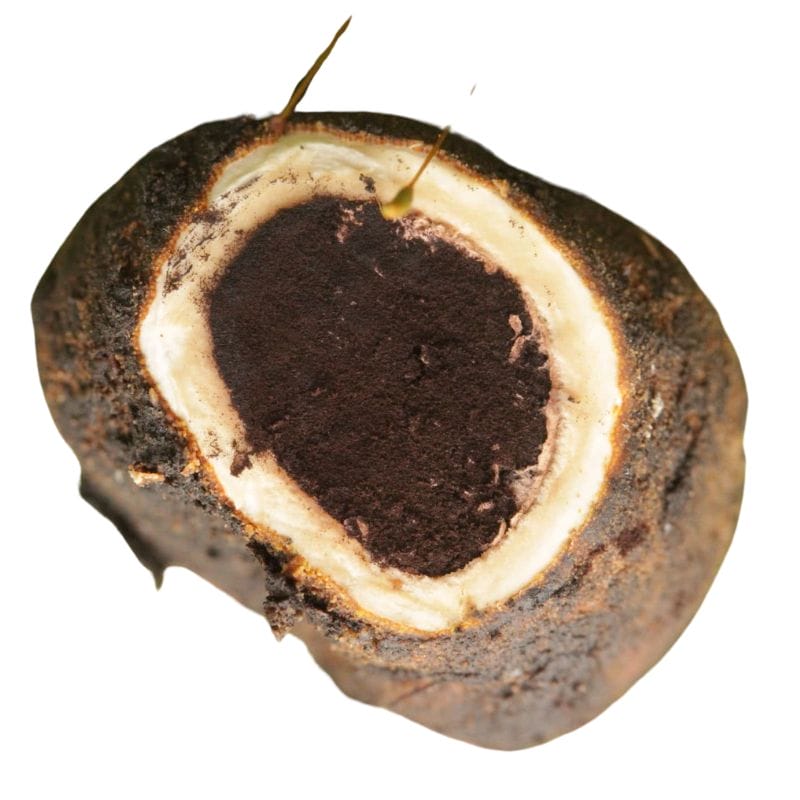
Elaphomyces, also known as deer truffles, look like true truffles at first glance, but they’re a whole different story. They’re called deer truffles because wildlife, especially deer and rodents, love to eat them. For us humans, though, they’re not edible—and definitely not what you want to mistake for a prized truffle.
Here’s how you can tell Elaphomyces apart from the real thing. First, they have a tough, warty outer surface that can range from pale tan to black, depending on the species and their age.
When you cut them open, the inside is solid and sometimes speckled or marbled, but not in the delicate, vein-like pattern you’d see in true truffles.
Their smell is also a big giveaway. Instead of the rich, earthy aroma of an edible truffle, Elaphomyces either has little scent or an odor that’s earthy but not particularly appealing.
Another thing to know is that Elaphomyces often grows deeper in the soil than true truffles, and they tend to have a harder, woodier texture.
Best Practices For Finding Truffles
Truffle hunting can be a rewarding adventure if you know the right tips and tricks. Here’s what you should keep in mind to improve your chances of finding these underground treasures:
Wait 10 to 14 Days After Heavy Rain
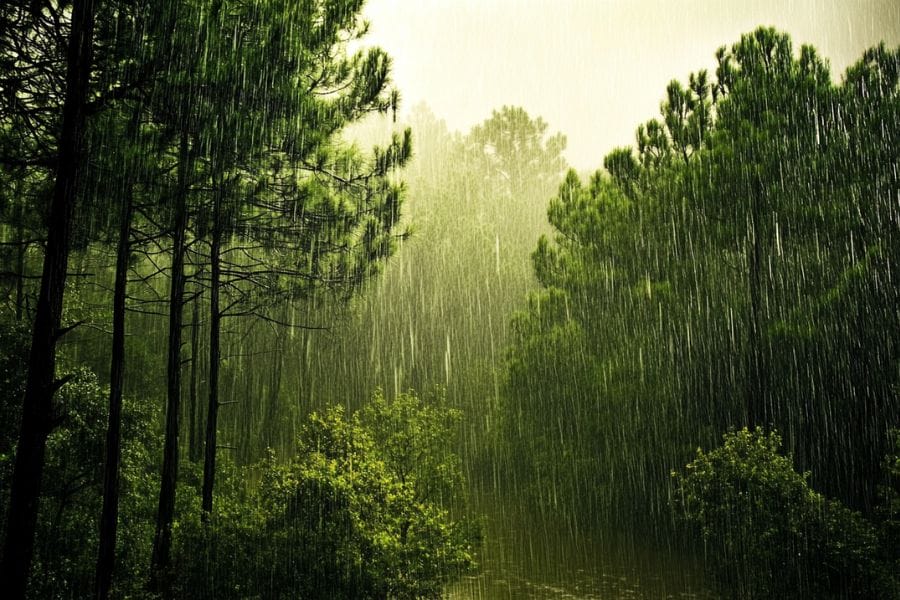
After a heavy rain, it’s best to wait about 10 to 14 days before heading out. This gives the truffles time to mature and release their signature aroma, making it easier for you (and your dog) to sniff them out. Rain helps truffles grow, but they don’t start giving off their scent right away.
As the soil warms up, the truffles get more aromatic, and the ground becomes looser, which makes digging easier without disturbing the environment too much. The timing is perfect to find truffles at their best—both in quality and in how easy they are to locate.
Find the Right Trees
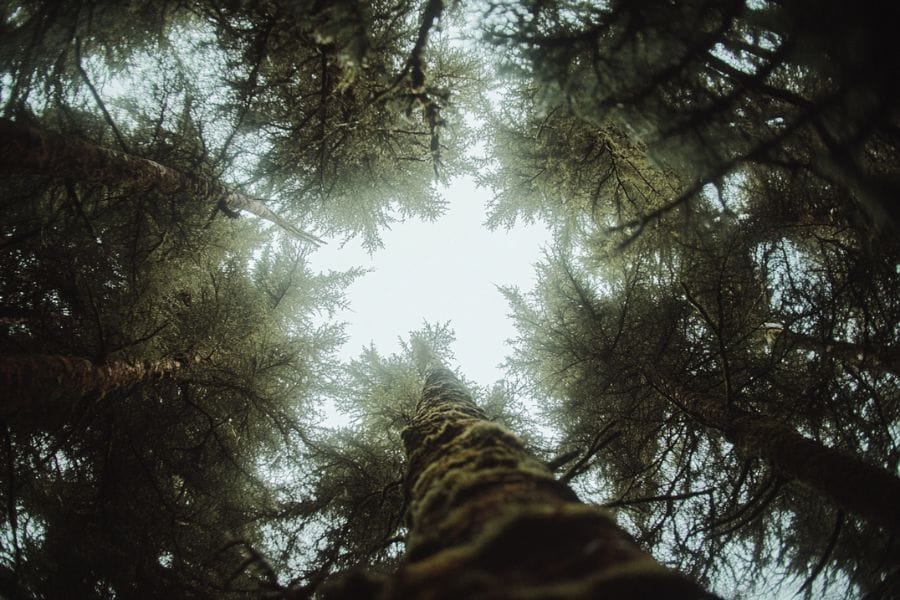
Truffles don’t grow just anywhere—they have a special relationship with certain trees. You won’t find them under just any tree, so knowing which ones to look for can make all the difference. Some of the best trees to look out for are:
- Pines
- Douglas-firs
- Oaks
- Hazelnuts
- Cypresses
- Willows
For example, if you’re looking for Oregon white truffles, keep an eye out for Douglas-fir trees. California black truffles, on the other hand, are often found near oaks and hazelnuts. The soil around these trees also needs to be slightly alkaline, so it helps to know what kind of ground you’re walking on as well.
Watch for Wildlife Activity
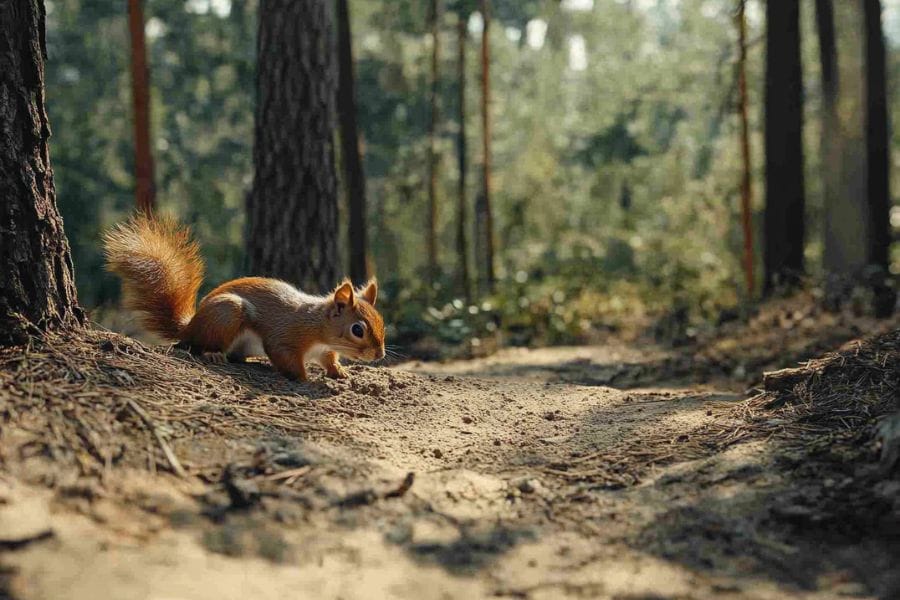
Animals like squirrels and chipmunks often help spread truffle spores, and sometimes their digging can lead you straight to truffles. While you won’t always find truffles in every pit animals dig (they also look for things like acorns or bulbs), fresh digs are a good clue. The more recent the pit, the better chance it has of leading to truffles.
Even though animals are a part of the truffle cycle, most hunters prefer using dogs to find the real treasure underground. Dogs have an incredible nose for truffles and can pinpoint their location much more reliably than any squirrel or chipmunk.
Get a Little Help from a Truffle-Hunting Dog
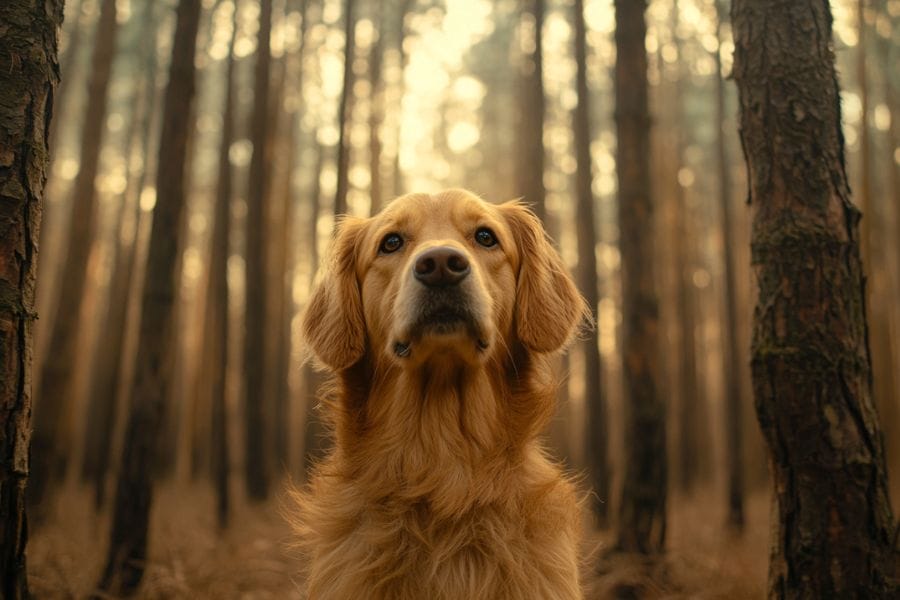
If you’re serious about truffle hunting, a trained dog can make your life a whole lot easier. Their sense of smell is extraordinary, and they’re trained to find mature truffles buried beneath the surface. Many truffle hunters swear by their dogs, and for good reason—they’re much more accurate than humans when it comes to sniffing out truffles.
If you don’t already have a trained dog, you can connect with local foraging groups or specialized trainers who offer truffle-hunting services. Some places even host events where you can see experienced handlers with their dogs in action. And if you’re feeling adventurous, you can train your own dog using truffle-scent kits and practice in a controlled space before hitting the woods.
Before you head out
Before embarking on any foraging activities, it is essential to understand and follow local laws and guidelines. Always confirm that you have permission to access any land and obtain permission from landowners if you are foraging on private property. Trespassing or foraging without permission is illegal and disrespectful.
For public lands, familiarize yourself with the foraging regulations, as some areas may restrict or prohibit the collection of mushrooms or other wild foods. These regulations and laws are frequently changing so always verify them before heading out to hunt. What we have listed below may be out of date and inaccurate as a result.
Where You Can Find Truffles Around The State
Now we’re going to go over five of the best locations for finding truffles. We’ll go a bit in-depth here and then provide a much longer list of other spots to try.
Superior National Forest
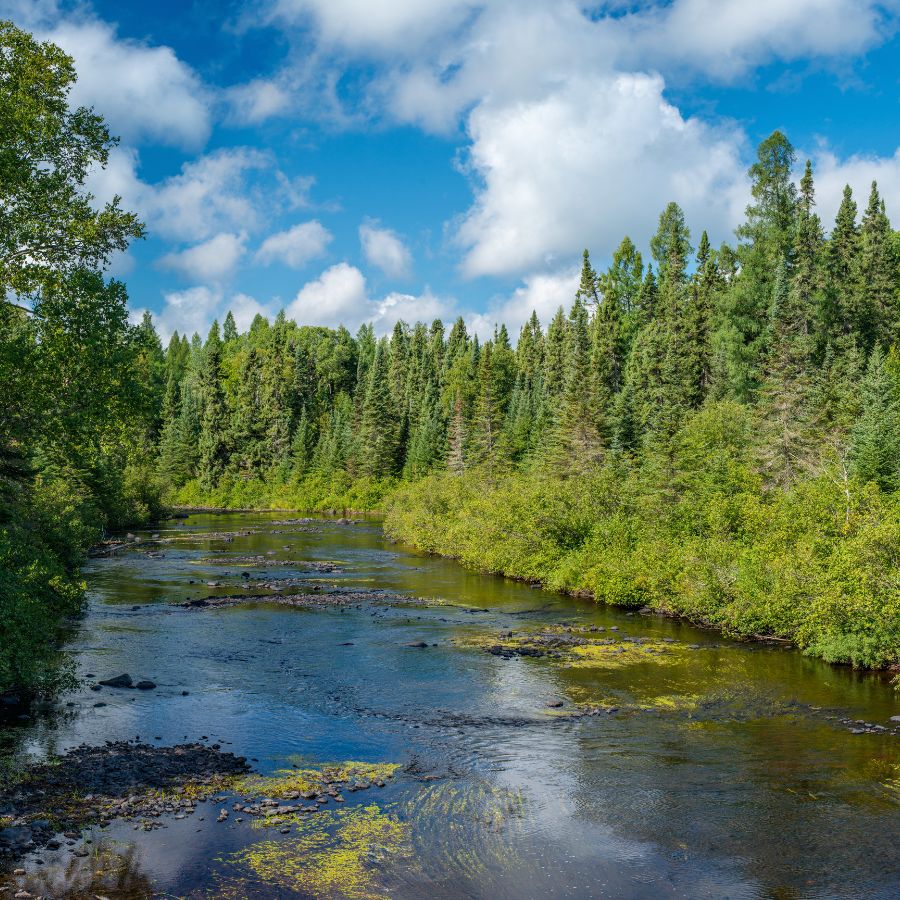
Superior National Forest borders Canada and stretches into the Arrowhead Region, where boreal forest transitions into northern hardwoods. Within that shift in terrain, patches of forest floor produce wild truffles in places where tree cover and moisture stay relatively consistent through the summer.
Near the Tomahawk Trail south of Greenwood Lake, the upland forest is dominated by jack pine and paper birch with scattered glacial till. These nutrient-poor soils support mycorrhizal fungi in unusual abundance, including truffles that grow quietly beneath the pine duff.
Just west of Lake Gegoka, an old network of snowmobile routes cuts through aspen-spruce groves. Even where the trail narrows, you can find wild truffles in the fir-rooted forest pockets tucked between wetlands and upland granite.
Closer to Isabella, the forest around the Little Isabella River features mixed terrain with long stretches of lowland fir and higher ridgelines of maple and aspen. The contrast between these elevation bands creates the kind of sheltered moisture zones that support wild truffle formation.
Chippewa National Forest
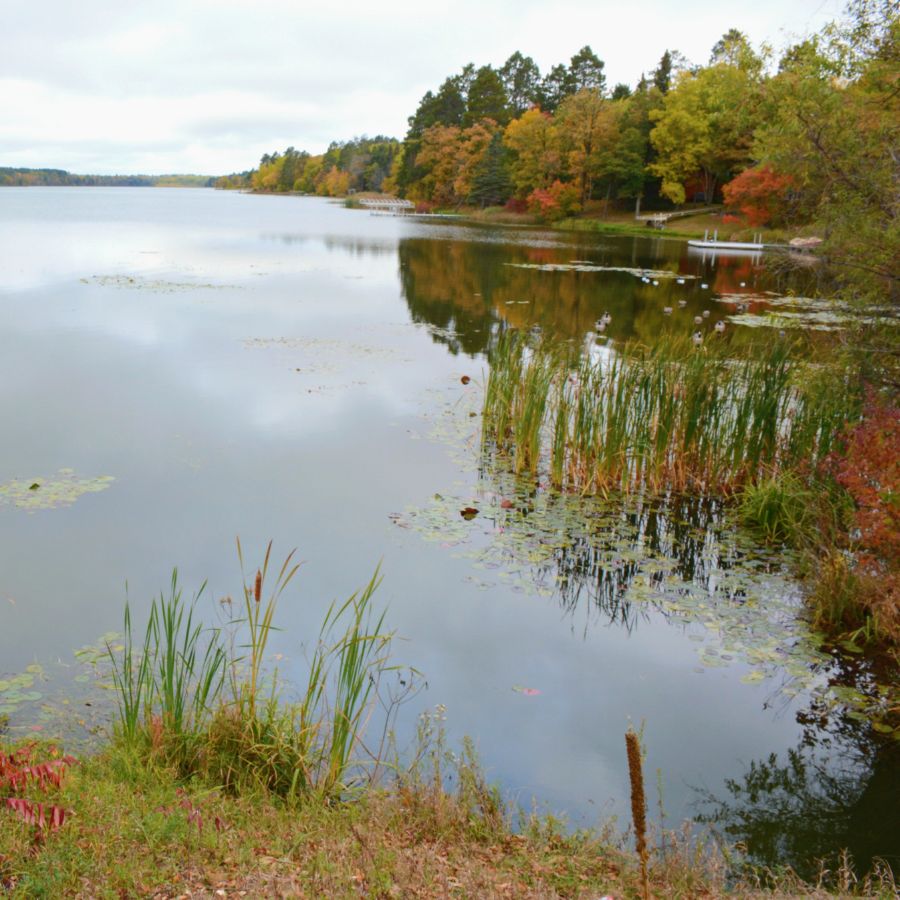
Chippewa National Forest is home to more than 1,300 lakes scattered across its northern Minnesota landscape. Near the quiet shoreline forests along the western edge of Pike Bay, you’ll find mixed hardwood cover and steady moisture where wild truffles have been known to thrive under the leaf litter.
South of Cass Lake, the Norway Beach Recreation Area offers more than just a popular campground. Beneath the aging red and white pines that line the interpretive trails, conditions are right for wild truffles tucked into the loamy forest floor.
The Cut Foot Experimental Forest sits on the northwestern edge of the national forest and features dense aspen stands along gravel roads and upland ridges. Where the older groves push up against seasonal wetlands, wild truffles can be found growing in shaded pockets under the leaf mold.
Just east of Winnie Dam, the trails around Mosomo Point wind through hemlock and fir stands that haven’t been heavily disturbed. In the quiet understory just off the trail, the thick duff layer supports fungal growth including wild truffles hidden among fallen needles and rotting wood.
Voyageurs National Park
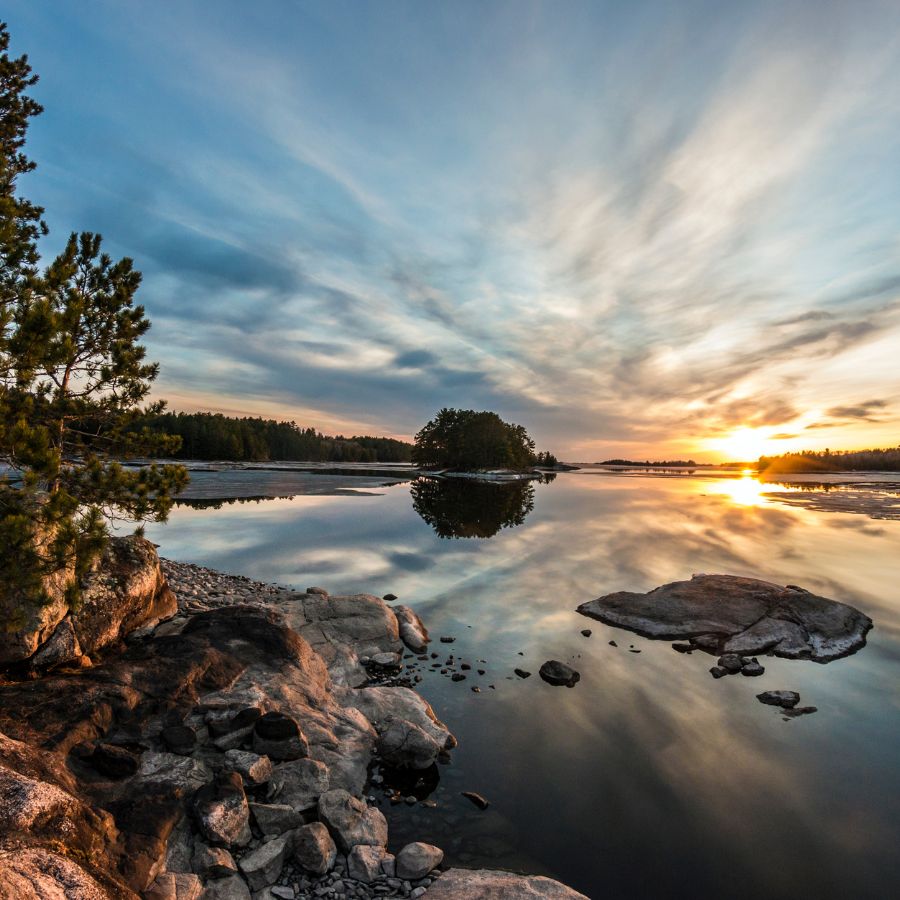
Voyageurs National Park contains over 500 islands scattered throughout four connected lakes. On the western end of Namakan Lake, the heavier soils beneath the tall jack pines around Junction Bay support wild truffles in the shaded forest floor between the rocky outcrops.
At the far eastern shore of Kabetogama Lake, you’ll pass through the forest near Cuculus Island where cedar and fir crowd close to the waterline. In the interior just beyond the mossy shoreline, wild truffles grow in pockets of undisturbed leaf litter and moist loam.
The wooded area between Anderson Bay and Wolf Point rises gradually from the lakeshore into a ridge of older deciduous trees. As you follow the slope toward the crest, watch for signs of wild truffles around the exposed roots and mushroom-rich detritus.
In the central part of the park, the trail system around the Black Bay Peninsula cuts through deep spruce stands and quiet upland meadows. Where those two environments overlap in the shadowy transition zones, wild truffles have been found in the damp mulch near the base of mature trees.
Itasca State Park
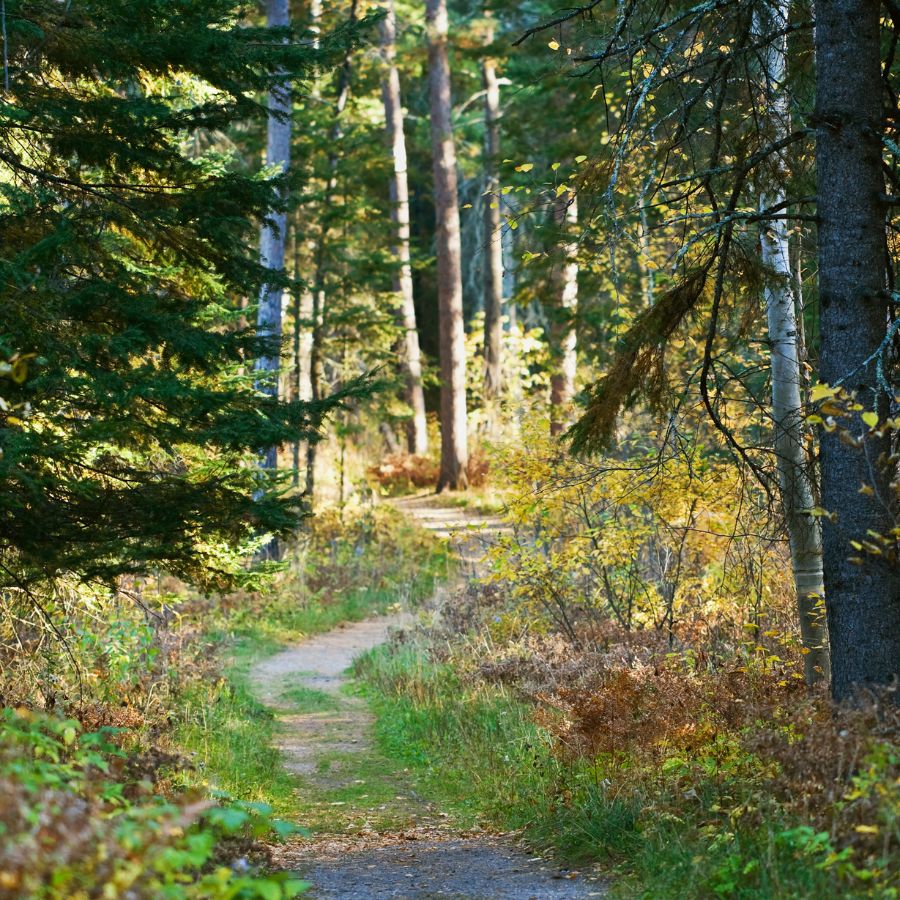
Itasca State Park features over 100 lakes within its boundaries, many of them hidden deep within thick northern forest. Among the smaller ones, Ryan Lake is surrounded by low ridges and quiet woods where wild truffles grow in rich, moist soil beneath birch and oak.
Moving west of the Douglas Lodge area, the trail toward Ozawindib Lake passes through a gently sloping woodland of maple, basswood, and scattered cedar. Wild truffles appear in the duff at the base of those trees where fallen branches trap moisture near the trail’s edge.
The northeast edge of the park near Nicollet Creek is full of soft, uneven terrain where springs feed into marshy valleys. In the higher patches between those drainages, wild truffles can be found growing among the roots of old maples and sugarbush remnants.
Between McKay Lake and the Pine Ridge Trail lies a mix of second-growth forest and scattered clearings that still hold moisture from old glacial runoff. In the hollows where these conditions meet, wild truffles grow well beneath layers of decomposing leaves and forest debris.
Richard J. Dorer Memorial Hardwood State Forest
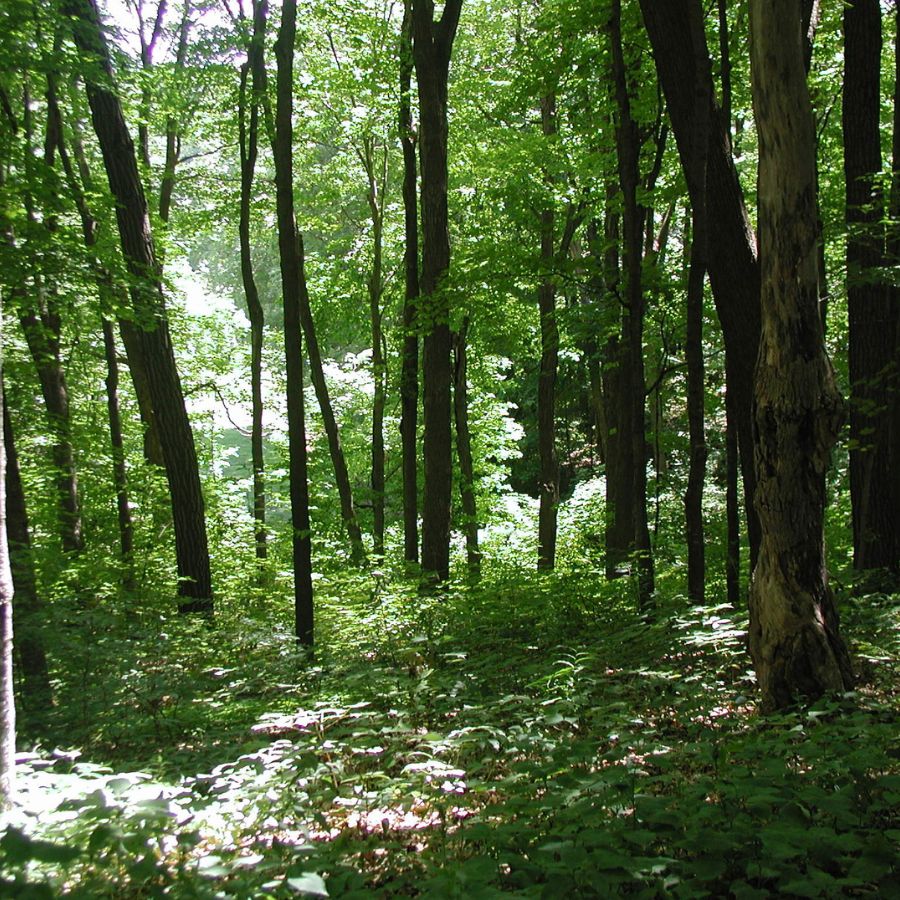
Richard J. Dorer Memorial Hardwood State Forest is known for its mix of steep hills and wooded valleys shaped by ancient glacial meltwater. Just north of Forestville Creek, those wooded slopes are dotted with scattered pines and hardwoods, and wild truffles grow close to the trunks where soil remains moist and cool.
The forested land between Rushford and Peterson contains deep gullies where snow lingers long into spring. Wild truffles are often found in those hollows near the Horse Camp Trail, especially under clumps of ironwood and oak along the shaded lower ridges.
To the west of Pilot Mound Township, the forest opens into a mosaic of small clearings, old logging roads, and second-growth maple woods. In the undisturbed patches tucked along the old roadbeds, wild truffles can be found near the base of trees where decaying leaves have built up over time.
Along Trout Run Creek, the forest narrows into a tight corridor flanked by steep, wooded hills that see little direct sunlight. The sloped terrain near the confluence with Coolridge Creek holds thick organic debris, and wild truffles grow well in that dark, spongey ground beneath the canopy.
Other Great Locations For Truffles
In addition to those key sites, several other forests and parks across Minnesota offer solid ground for wild truffles:
| Central | What’s allowed & why it’s good truffle ground |
| Charles A. Lindbergh State Park | Lowland ash-maple groves near the river; DNR rules allow foraging for mushrooms. |
| Crow Wing State Park | Sandy hardwood forest near the Mississippi; DNR allows mushroom foraging. |
| Cuyuna Country State Recreation Area | Regrown mine lands have truffle-suitable birch stands; DNR foraging allowed. |
| Lake Maria State Park | Big woods remnants favor truffle fungi; foraging mushrooms is allowed by DNR policy. |
| William O’Brien State Park | Forested hills near the St. Croix shelter truffle fungi; foraging mushrooms is permitted. |
| North–Central | What’s allowed & why it’s good truffle ground |
| Chippewa National Forest | Mixed hardwood lowlands support summer truffles; USFS personal-use foraging is allowed. |
| Voyageurs National Park | Remote upland forests hide truffles; NPS bans foraging without research permit. |
| Itasca State Park | Mature maple stands near Lake Itasca; DNR allows foraging in state parks for mushrooms. |
| McCarthy Beach State Park | Upland hardwoods and damp ridges suit truffle growth; DNR allows mushroom foraging. |
| Lake Bemidji State Park | Cedar swamps and hardwood fringe forest support truffles; DNR foraging allowed. |
| Northeast | What’s allowed & why it’s good truffle ground |
| Superior National Forest | Birch–pine glades near glacial ridges give fall truffles; USFS foraging allowed. |
| Jay Cooke State Park | Hemlock and sugar maple slopes stay moist; DNR allows mushroom foraging. |
| Savanna Portage State Park | Old-growth pockets along the Continental Divide hold ground truffles; DNR permits foraging. |
| Bear Head Lake State Park | Spruce–fir flats near bogs give fall truffles; mushroom foraging is allowed by DNR. |
| Moose Lake State Park | Spruce–birch forest near wet lowlands; mushroom foraging allowed in state parks. |
| Southeast | What’s allowed & why it’s good truffle ground |
| Richard J. Dorer Memorial Hardwood State Forest | Bluff oak-maple forests fruit truffles; state forest policy allows personal-use foraging. |
| Carley State Park | Bigleaf forest in Whitewater valley holds spring truffles; DNR permits mushroom gathering. |
| Nerstrand Big Woods State Park | Dense big woods with sugar maple cover support ground truffles; DNR allows foraging. |
| Rice Lake State Park | Moist hardwoods on the lake’s edge fruit summer truffles; DNR allows mushroom foraging. |
| West–Central | What’s allowed & why it’s good truffle ground |
| Lake Carlos State Park | Rolling glacial terrain with mature oak stands; mushroom foraging is permitted. |
| Maplewood State Park | Hardwood hills near glacial lakes create good truffle habitat; DNR allows foraging. |
When The Best Time Of The Year Is To Find Truffles
The best time to hunt for truffles in Florida typically falls during the cooler months, from late fall to early spring. These months provide the right combination of moisture and moderate temperatures for truffle growth.
After a period of heavy rain, waiting 10-14 days allows the soil to stabilize and the truffles to mature, enhancing their aroma. Focus on mornings or cool, overcast days to improve conditions for foraging, as truffle scent is more pronounced in cooler, damp environments.
Seasonal timing is key, as Florida’s warm, humid climate can impact truffle availability outside of these optimal months.
One Final Disclaimer
The information provided in this article is for general informational and educational purposes only. Foraging for wild plants and mushrooms involves inherent risks. Some wild plants and mushrooms are toxic and can be easily mistaken for edible varieties.
Before ingesting anything, it should be identified with 100% certainty as edible by someone qualified and experienced in mushroom and plant identification, such as a professional mycologist or an expert forager. Misidentification can lead to serious illness or death.
All mushrooms and plants have the potential to cause severe adverse reactions in certain individuals, even death. If you are consuming foraged items, it is crucial to cook them thoroughly and properly and only eat a small portion to test for personal tolerance. Some people may have allergies or sensitivities to specific mushrooms and plants, even if they are considered safe for others.
Foraged items should always be fully cooked with proper instructions to ensure they are safe to eat. Many wild mushrooms and plants contain toxins and compounds that can be harmful if ingested.

